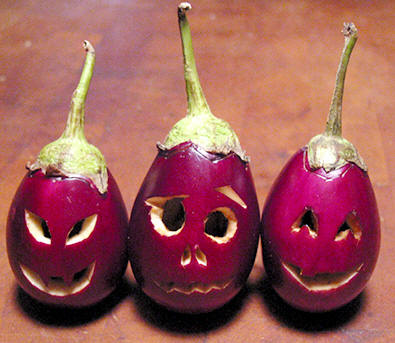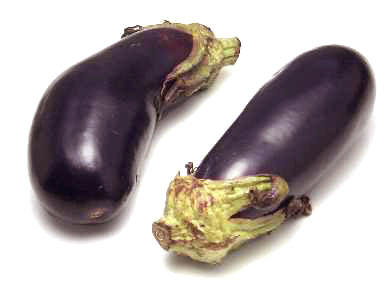Let's Cook It Up, Cassie!

When Cassie (our granddaughter) lived in California she loved to cook and her favorite was "Cassie s Casserole" .
We would go into the garden and pick the eggplants and wah them up. Grandpa would slice them as Cassie was a bit young for a really sharp knife!
Grandma and Cassie would prepare the baking plans, put on the aluminum foil, cook the eggplant and giggle a lot!
Then her favorite part, putting in the eggplant and doing all the different layers! Cassie was excellent at layering the tomatoes and she loved the various colors of tomatoes we would use.
We will never forget those special days with Miss Cassie.
She is now years old and getting prettier every day!.
Sometime when she returns to California we will have to make some more "Cassie's Casserole".
It all starts in the garden!
Eggplant Is Delicious Baked And Used With Other Items
Did You Know? - The eggplant is an important food crop grown for its fruit, which can be any size from small to large and pendulous, depending on cultivar, and might be many colors, especially purple, green, or white. It has been cultivated in southern and eastern Asia since prehistory but appears to have become known to the Western world no earlier than ca. 1500 CE. The first known written record of the eggplant is found in Qí mín yào shù, an ancient Chinese agricultural treatise completed in 544 CE.
We found the eggplant

The eggplant is a member of the nightshade (Solanaceae) family to it is akin to the potato, tomato as well as the tomatillo and chayote. Although we use the eggplant as a vegetable it is really a fruit.
While there are many variations of eggplant the most common in the US are “Black Beauty” (the large, dark glossy typical grocery store variety) and Japanese, the long slender version sometimes light purple. If you follow some of the links in this article you will learn about an amazing array of eggplant fruits in various colors, shapes and sizes.
The English actually gave the fruit the name of "eggplant" referring one varieties shape which was similar to an egg. To much of Europe the eggplant is referred to as an "aubergine" and Italy it is called melanzana.
History

The eggplant is native to India and Pakistan and was first domesticated over 4000 years ago. The fruit was introduced to China around 500 B.C. The Chinese hybridized their own varieties of different shaped and colored eggplants.
The migration of the eggplant continued in the 9 – 12th centuries to the Middle East and westward to Egypt. The moors introduced the eggplant to the Spaniards and the fruit became popular all over Europe. The Spaniards thought the eggplant was an aphrodisiac and referred to as “Berengenas” or “The Apple of Love”. This of course added greatly to the popularity of the unusual fruit.
Wash them up, clean behind their ears
Peel the eggplant
Chop it up into slices
Did You Know? - A casserole, from the French word for "saucepan"] is a large, deep dish used both in the oven and as a serving vessel. The word casserole is also used for the food cooked and served in such a vessel, with the cookware itself called a casserole dish or casserole pan. In British English, this type of dish is frequently also called a bake, coinciding with the cooking technique used to cook casseroles. In Minnesota, this type of dish is sometimes called "hotdish".
Meanwhile, get some interesting tomatoes
Of course, basil
Prepare a cooking sheet with foil and grease
Did You Know? - Aluminum Foil is made made from a thin leaf of tin was commercially available before the aluminum counterpart. In the late 19th century and early 20th century , tin foil was in common use, and some people continue to refer to the new product by the name of the old one. Tin foil is stiffer than aluminum foil. It tends to give a slight tin taste to food wrapped in it, which is one major reason it has largely been supplanted by aluminum and other materials for wrapping food.
Finish chopping the eggplant into small pieces
Keep on going
Lay the eggplant down so pieces do not touch
Drizzle oil oil and some seasoned salt onto the eggplant
Did You Know? - Olive oil is a vegetable oil obtained from the olive (Olea europaea), a traditional tree crop of the Mediterranean Basin. It is used in cooking, cosmetics, pharmaceuticals, and soaps, and as a fuel for traditional oil lamps. Olive oil is a healthful oil because of its high content of monounsaturated fat (mainly oleic acid) and polyphenols.
Over 750 million olive trees are cultivated worldwide, with about 95 percent in the Mediterranean region. About three-quarters of global olive oil production comes from European Union member states; of the European production, 77 percent comes from Spain, Italy, and Greece; Spain alone accounts for more than 40 percent of world production. Much of the Spanish crop is exported to Italy, where it is both consumed and repackaged for sale abroad as olive oil "imported from Italy".
The province of Jaen, Spain in general, and the city of Martos in particular claims to be the “World Capital of olive oil” as the largest producer of olive oil in the world.
In olive oil-producing countries, the local production is generally considered the finest. In North America, Italian olive oil is the best-known, but top-quality extra-virgin oils from Spain, Greece, and France (Provence) are sold at high prices, often in 'prestige' packaging.
Greece devotes 60 percent of its cultivated land to olive-growing. It is the world's top producer of black olives and boasts more varieties of olives than any other country. Greece holds third place in world olive production with more than 132 million trees, which produce approximately 350,000 tons of olive oil annually, of which 75 percent is extra-virgin (see below for an explanation of terms).
This makes Greece the world's biggest producer of extra-virgin olive oil, topping Italy (where 40-45 percent of olive oil produced is extra virgin) or Spain (where 25-30 percent of olive oil produced is extra virgin). About half of the annual Greek olive oil production is exported, while only some 5 percent of this quantity reflects the origin of the bottled product. Greek exports primarily target European Union countries, the main recipient being Italy, which receives about three-quarters of total exports. Olives are grown for oil in mainland Greece, with Peloponnese being the source of 65 percent of Greek production, as well as in Crete, the Aegean Islands and Ionian Islands.
Do not overkill
Prepared the tomatoes
Roast at 350 for about 15 minutes or until they begin to turn brown
Put into a container for use now or in the future
Inn the pan put down a layer of eggplant
Then a layer of tomatoes
Keep repeating until the pan is full
Put cheese across the top
Put into a water bath so we do NOT burn the bottom\. About 15 minutes at 400 in the oven will bring out a golden color... times may vary!
Voila.... Eggplant is ready to eat